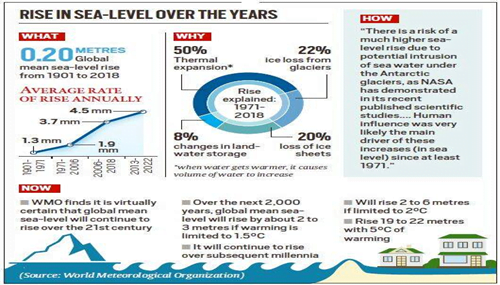Environment & Ecology
Context: Recently, the report “Global Sea-level Rise and Implications” was released by the World Meteorological Organisation (WMO).
Key highlights of the report:

- Threats of Sea level rise: India, China, Bangladesh and the Netherlands face the highest threat of sea-level rise globally.
- The report stated that several big cities in all continents are threatened by the rise in sea level.
- These include Shanghai, Dhaka, Bangkok, Jakarta, Mumbai, Maputo, Lagos, Cairo, London, Copenhagen, New York, Los Angeles, Buenos Aires and Santiago.
- Stimulating factors: If trends in urbanisation in exposed areas continue, this will exacerbate the impacts, with more challenges where energy, water and other services are constrained,” it reported.
- The impacts of average sea-level rise are boosted by storm surges and tidal variations, as was the situation during the landfall of hurricane Sandy in New York and Cyclone Idai in Mozambique.
- Melting of ice mass in Antarctica: According to future estimates based on climate models and ocean-atmosphere physics, the WMO reported that the speed of melting of the largest global ice mass in Antarctica is uncertain.
Impact of Sea level rise:
- Submergence: According to the report, while sea-level rise is not globally uniform and varies regionally, continued and accelerating sea-level rise will encroach on coastal settlements and infrastructure and commit low-lying coastal ecosystems to submergence and loss.
- All round impact: Sea level rise is a major economic, social and humanitarian challenge.
- It threatens coastal farmlands and water reserves and resilience of infrastructures as well as human lives and livelihoods, the report noted.
- Food insecurity: Climate change will increasingly put pressure on food production and access, especially in vulnerable regions, undermining food security and nutrition and increases in frequency, intensity and severity of droughts, floods and heatwaves, and continued sea level rise will increase risks to food security in vulnerable regions.
Primary reasons for the Sea Level Rise: The change in sea levels is linked to three primary factors, all induced by ongoing global climate change:
- Melting glaciers:
- Large ice formations such as mountain glaciers naturally melt a bit each summer.
- In the winter, snows, primarily from evaporated sea water, are generally sufficient to balance out the melting.
- Recently, though, persistently higher temperatures caused by global warming have led to greater than average summer melting as well as diminished snowfall due to later winters and earlier springs.
- Thermal expansion:
- When water heats up, it expands.
- About half of the sea-level rise over the past 25 years is attributable to warmer oceans simply occupying more space.
- Loss of Greenland and Antarctica’s ice sheets:
- As with mountain glaciers, increased heat is causing the massive ice sheets that cover Greenland and Antarctica to melt more quickly.
- Scientists also believe that meltwater from above and seawater from below is seeping beneath Greenland’s ice sheets, effectively lubricating ice streams and causing them to move more quickly into the sea.
- While melting in West Antarctica has drawn considerable focus from scientists, especially with the 2017 break in the Larsen C ice shelf, glaciers in East Antarctica are also showing signs of destabilizing.
Way Forward:
- Coastal cities and settlements play a key role in moving toward higher climate resilient development given firstly, almost 11% of the global population of 896 million people lived within the Low Elevation Coastal Zone in 2020, potentially increasing to beyond 1 billion people by 2050.
- These people, and associated development and coastal ecosystems, face escalating climate compounded risks, including sea level rise.
- The Coastal cities can implement the following measures to address sea level rise
- Using Beaches As Barriers
- Building Seawalls
- Raising Roads
- Building Stormwater Pumps
- Upgrading Sewage Systems
- Creating Natural Infrastructure
- Slowing Land Sinkage
- Global Plans to reduce the impacts of Sea Level rise:
- In Jakarta, a $40 billion project will aim to protect the city with an 80-foot-high seawall.
- Rotterdam, home to the global Centre on Adaptation, has offered a model to other cities seeking to combat flooding and land loss.
- The Dutch city has built barriers, drainage, and innovative architectural features such as Water Square with temporary ponds.
Source: Indian Express












